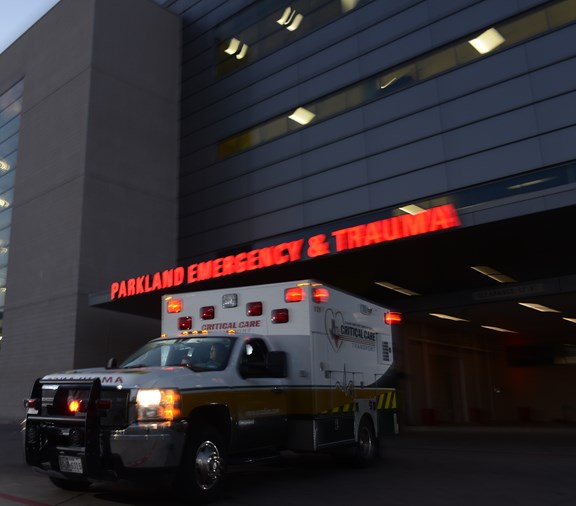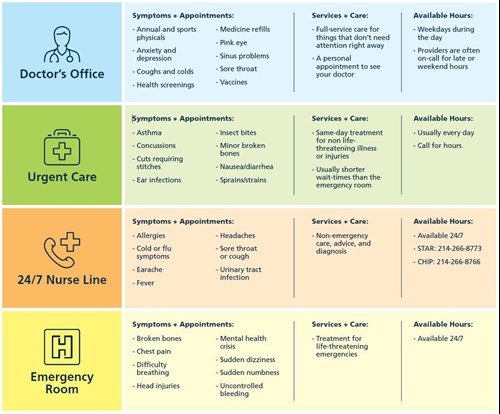
When To Go To The Emergency Room vs Urgent Care
September 23, 2020
When medical situations occur, we’re often faced with uncertainty about where to go for care, especially if the symptoms seem severe and our regular doctor’s office is closed. While the answer is not always simple, knowing the difference between walk-in clinics, urgent care and emergency care and where to seek treatment could save your life in a medical emergency.
The differences between walk-in clinics, urgent care and the emergency room
Recognizing the differences between ‘emergency’ and ‘urgent’ care can be confusing, because both terms imply there is a medical need that needs to be addressed quickly. However, there are distinct differences between hospital emergency rooms, traditional urgent care centers or walk-in clinics, including the level of care that can be provided at each.
Urgent care or walk-in clinics help fill a vital gap when you become sick or injured, but your regular doctor is not available and you can’t wait for an appointment.
Hospital emergency departments provide medical care at any time, day or night. However, unlike urgent care centers or walk-in clinics, they are equipped and staffed for even the most complex or critical needs, including life- and limb-threatening situations ranging from heart attack and stroke to traumatic injuries following a car accident.
When to go to your doctor's office or a walk-in clinic
Your doctor's office and walk-in clinics offer fast, convenient access to medical care. Call your doctor's office to schedule an appointment. Walk-in clinics do not need appointments and they are generally staffed by nurse practitioners and physician assistants. These clinics address the most minor of ailments, such as:
- Rashes without fever
- Mild flu-like symptoms
- Cough and congestion symptoms
- Sore throat
- Ear pain
- Eye redness, discharge or itchiness
- Painful urination
They also provide additional services, such as sports physical, health screenings and vaccines. They are a good option for when you are not feeling well, but it’s not serious enough for the emergency room or urgent care.
If you get sick at night or on a weekend and cannot wait to get medical care, call the Parkland 24-hour Nurse Line at 1-888-667-7890 or 214-266-8773 to speak with a registered nurse to help you decide what to do. You can talk to a nurse 24 hours a day, 7 days a week.
When to go to urgent care
Urgent care is not emergency care. A study conducted by the National Center for Health Statistics found that among patients who had visited the emergency room but were not admitted to the hospital, 48 percent went there because their doctor’s office was not open.
Urgent care centers are same-day clinics that can handle a variety of medical problems that need to be treated right away, but are not considered true emergencies. Symptoms that can be evaluated and treated at an urgent care clinic include:
- Vomiting or persistent diarrhea
- Abdominal pain
- Wheezing or shortness of breath
- Dehydration
- Sprains and strains
- Small cuts that may require stitches
If your symptoms come on gradually or you already know the diagnosis — for example, you have repeat urinary tract infections, or you recognize when your child has come down with an ear infection — it’s worth calling your primary care doctor’s office to see if you can get a same-day appointment. After all, your primary care doctor knows your health history, including what treatments have worked best in the past and whether you have other medical conditions that need to be taken into consideration.
However, while urgent care clinics are not a substitute for your primary care physician, they are a great resource when you need care but can’t get in with your doctor.
When to go to the ER
There are a number of medical conditions that are considered emergencies because they can require rapid or advanced treatments (such as surgery) that are only available in a hospital setting.
Symptoms that are best evaluated in an emergency room include:
- Chest pain or difficulty breathing
- Weakness/numbness on one side
- Slurred speech
- Fainting/change in mental state
- Serious burns
- Head or eye injury
- Concussion/confusion
- Broken bones and dislocated joints
- Fever with a rash
- Seizures
- Severe cuts that may require stitches
- Facial lacerations
- Severe cold or flu symptoms
- Vaginal bleeding with pregnancy
When to call 9-1-1
You should never drive yourself if you are having severe chest pain or severe bleeding, if you feel like you might faint or if your vision is impaired. When in doubt, please call 9-1-1 — what matters most is that you get to the emergency room quickly and safely.
For certain medical emergencies such as a heart attack or stroke, calling 9-1-1 for an ambulance is always the right decision. This is because paramedics often can begin delivering life-saving treatment on the way to the hospital.
How to be prepared
This infographic from PCHP offers information about when you should go to a walk-in clinic or urgent care, and when it’s time for the emergency room.
Whether you’re going to a walk-in clinic, urgent care center, the ER or your primary care physician’s office, it’s a good idea to bring a list of all the medications you take, including over-the-counter medicine, vitamins and supplements. This list should include how much of each medication you take as well as how often you take it.
Also keep with you a list of any allergies (including medication allergies) and any previous medical procedures or surgeries you’ve had. When listing procedures and surgeries, note the dates they were performed and the names of the physicians or surgeons who treated you.





